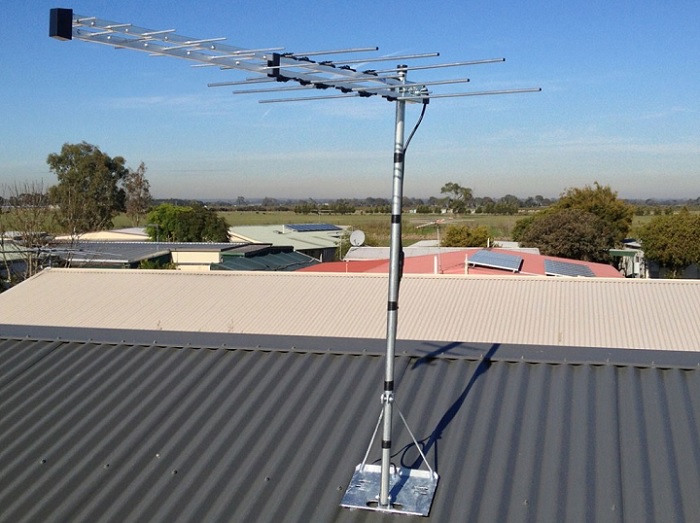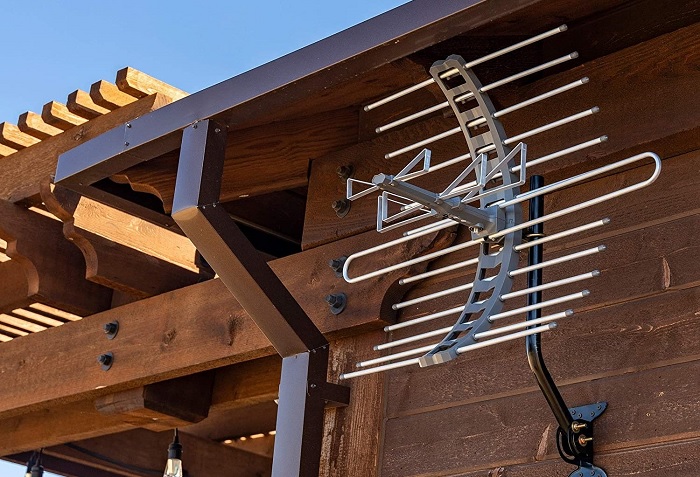With the growing demand for high-quality television broadcasts and the increasing number of cord-cutters, outdoor TV antennas have gained popularity as an effective solution to access free over-the-air channels.
Mounting the antenna outdoors ensures better signal reception and improved picture quality. This article explores various outdoor TV antenna mounting options and offers essential tips to optimize your antenna setup for an optimal viewing experience.
Outdoor TV Antenna Mounting Options
1. Rooftop Mounting

Rooftop mounting is a popular and effective method for installing outdoor TV antennas. It offers several advantages, primarily providing elevation and reducing obstructions that might hinder the antenna’s line of sight to broadcasting towers. Elevated positioning enhances signal reception, leading to improved picture quality and a broader range of available channels.
To properly rooftop mount your TV antenna, follow these steps:
- Sturdy Mounting Bracket: Select a robust and weather-resistant mounting bracket that can securely attach to the roof. It’s essential to avoid any damage to the roof’s structure during installation.
- Location Consideration: Choose a strategic location on the rooftop with a clear line of sight to broadcasting towers. Use a compass or online signal locator tools to determine the best direction to point the antenna.
- Antenna Positioning: Aim the antenna towards the broadcasting towers to achieve the best possible signal reception. Slight adjustments in the antenna’s direction can significantly impact signal strength.
- Grounding: Proper grounding is crucial for safety, especially during lightning storms. Install a grounding block and grounding wire connected to a designated grounding rod to protect your antenna setup.
- Weatherproofing: Seal any exposed connections and cables with weatherproofing materials to safeguard against moisture and ensure long-lasting performance.
2. Attic Mounting

When rooftop mounting is not feasible due to restrictions or aesthetic concerns, attic mounting offers an alternative solution. While it provides some level of protection from weather elements, it may result in slightly reduced signal strength compared to rooftop installations due to the attic’s insulation and roofing materials. However, if your location is close to broadcasting towers, attic mounting can still be effective.
Follow these tips for attic mounting:
- Signal Considerations: Check signal strength in the attic before installation to ensure satisfactory reception. Weak signals might require additional signal amplification.
- Adequate Ventilation: Ensure proper attic ventilation to prevent heat buildup and potential damage to the antenna and associated equipment.
- Outdoor-rated Antenna: Use an outdoor-rated antenna even if it’s placed in the attic. Outdoor antennas are designed to withstand environmental factors better, ensuring better performance and longevity.
- Grounding: As with rooftop installations, grounding the attic-mounted antenna is essential for safety reasons.
3. Wall Mounting

Wall mounting is an ideal choice when you have limited outdoor space or if you’re renting a property and need a temporary solution. It involves attaching the antenna to an exterior wall using a mounting bracket.
Consider the following when wall mounting your outdoor TV antenna:
- High-quality Bracket: Use a high-quality and rust-resistant bracket that securely attaches to the wall.
- Height Placement: Position the antenna as high as possible on the wall to improve the line of sight to broadcasting towers.
- Obstructions: Be mindful of potential obstructions that may obstruct the antenna’s line of sight, affecting signal reception.
- Signal Amplification: If your location is far from broadcasting towers or has weak signals, consider using a signal amplifier to boost reception.
4. Tripod Mounting
Tripod mounting is a temporary solution suitable for camping trips, outdoor events, or situations where portability is essential. Tripod mounts are lightweight, easy to set up, and adjustable to achieve the best signal reception.
Here are some tips for using a tripod mount:
- Portable Antenna: Choose a compact and portable outdoor TV antenna specifically designed for tripod mounting.
- Stability: Ensure the tripod is stable and securely placed to avoid any accidental tipping or falling.
- Signal Strength: Check signal strength in the area to ensure satisfactory reception before setting up the tripod.
- Temporary Use: Keep in mind that tripod mounts are designed for temporary use and may not provide the same signal quality and stability as permanent installations.
Tips for Optimizing Outdoor Antenna Performance
Choose the Right Antenna: Research the type of TV antenna suitable for your location, considering factors like distance from broadcasting towers, terrain, and surrounding obstacles. Directional antennas work well in areas with strong signals from a particular direction, while multi-directional antennas are better for locations with signals coming from multiple directions.
Ground the Antenna: Properly ground the outdoor TV antenna to protect against lightning strikes and static electricity buildup. Use a grounding block and grounding wire connected to a designated grounding rod.
Use Coaxial Cable: High-quality coaxial cable is essential to minimize signal loss. Choose a low-loss cable and keep the cable runs as short as possible.
Aim the Antenna: Orient the antenna towards broadcasting towers for optimal signal reception. Utilize signal locator tools or apps to identify tower locations and align the antenna accordingly.
Where is the best place to mount an outdoor TV antenna?
The best place to mount an outdoor TV antenna is in a spot that gives you a clear line of sight to the broadcast towers. This is usually on the roof of your home, but it could also be on a wall or chimney. If you live in an area with a lot of trees or hills, you may need to mount the antenna higher in order to get a good signal.
How to position the outdoor antenna for best reception?
Once you’ve mounted your antenna, you need to position it in the direction of the broadcast towers. You can use a website like AntennaWeb or RabbitEars.info to find out where the broadcast towers are located in your area. Once you know where the towers are, you can use a compass to point the antenna in the right direction.
How do you mount an outdoor antenna?
There are a few different ways to mount an outdoor TV antenna. You can use a roof mount, a wall mount, a chimney mount, or an antenna mast. The best mounting method for you will depend on the location of your antenna and the height you need to achieve.
What is the best height for an outdoor TV antenna?
The higher the antenna, the better the reception. If you can, mount the antenna as high as possible. If you’re mounting the antenna on your roof, make sure to use a roof mount that is designed for high winds.
How can I make my outdoor antenna stronger?
There are a few things you can do to make your outdoor antenna stronger. You can use a larger antenna, you can mount the antenna higher up, or you can use a signal booster. If you’re using a signal booster, make sure to choose one that is designed for the frequency range of the channels you want to receive.
Should TV antenna be vertical or horizontal?
The orientation of your TV antenna will depend on the type of signal you’re receiving. VHF signals are typically received better with a vertical antenna, while UHF signals are typically received better with a horizontal antenna. If you’re not sure which type of signal you’re receiving, you can try both orientations and see which one works better for you.
Conclusion
Mounting your outdoor TV antenna effectively is crucial to ensure reliable and clear reception of free over-the-air channels. Whether you opt for rooftop, attic, mast pole, wall, or tripod mounting, consider the specific needs of your location and follow the provided tips to optimize your antenna setup.
With a well-installed outdoor TV antenna, you can enjoy high-definition broadcasts and access numerous free channels, enhancing your television viewing experience while cutting the cord on expensive cable subscriptions.
